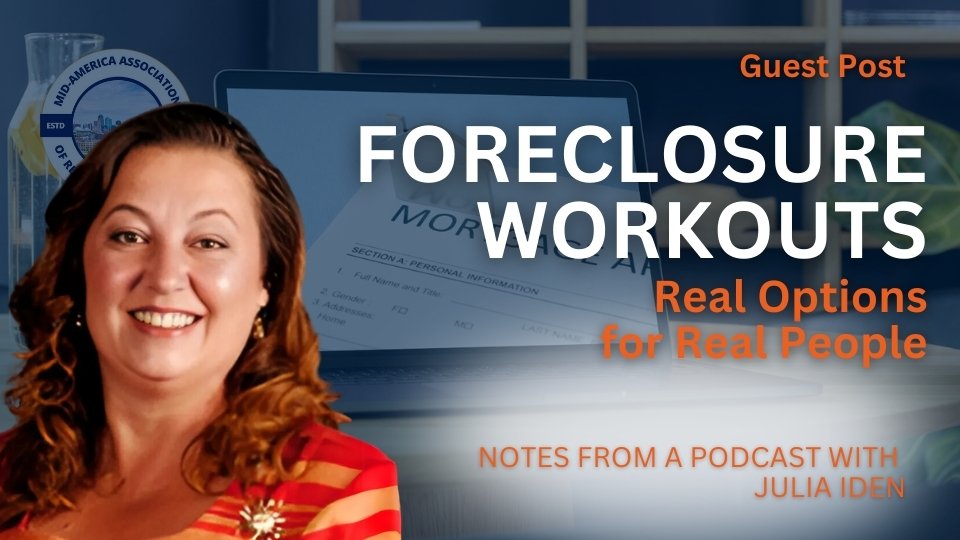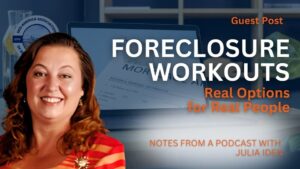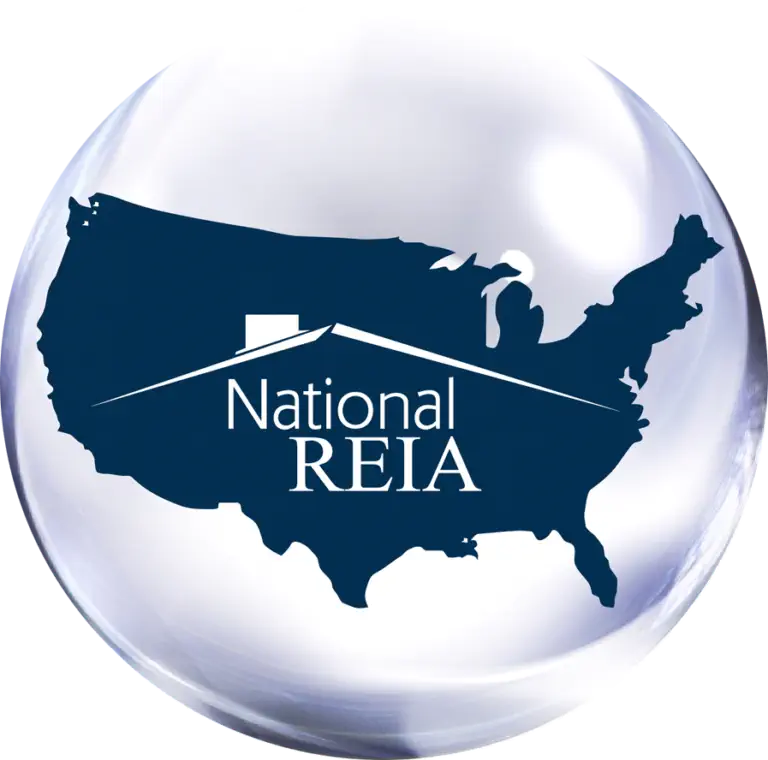
If you’re a real estate investor or agent working with distressed homeowners, understanding foreclosure workout options isn’t just helpful — it’s essential. The better you understand what truly happens behind the scenes at mortgage servicing companies, the better you can guide sellers, protect deals, and even uncover opportunities others miss. I just listened to a game-changing podcast featuring Julia Iden, President of Advanced Mortgage Education, and it was packed with must-know insights about how workouts actually work — from forbearances and loan mods to short sales and deed-in-lieu strategies. Whether you want to help clients stay in their home or exit with dignity, these are the tools you need in your back pocket.
Foreclosure Workouts
First Things First: Do You Want to Stay or Go?
Everything starts with one simple question: Do you want to keep your home, or do you want to move on?
Your answer determines which bucket of options might apply:
Cure-related workouts: Help you stay in the home and bring the mortgage current.
Non-cure workouts: Help you exit the home without going through a full foreclosure.
Let’s walk through both, starting with staying put.
Want to Stay in Your Home? These Are the Cure-Related Options
1. Moratoriums
If your financial hardship stems from a declared disaster—like a hurricane, flood, fire, or snowstorm—you might qualify for a moratorium. This puts your mortgage on pause (no payments due, no credit reporting, no late fees) while you focus on repairing your home. Julia explained how homeowners usually get 6–12 months, and at the end, the missed payments are simply added to the back of the loan. It’s a big break if your house got hit by disaster.
2. Special Forbearance
A special forbearance is short-term relief. Think layoffs, surgeries, or waiting on a legal settlement. You might make reduced payments—or none at all—for several months. This will impact your credit, but it buys time while life stabilizes. Julia shared emotional examples, including a homeowner battling a terminal illness who used this time to secure funds from a life insurance policy.
3. COVID Forbearance
During the pandemic, millions of homeowners took advantage of COVID-related forbearances. These didn’t ding credit, and borrowers could skip payments for up to 24 months. But here’s the kicker: Many borrowers misunderstood the terms. They thought they’d repay gradually—one extra payment a month. In reality? A balloon payment is due at the end unless another plan is worked out.
Pro Tip: If you took a COVID forbearance, talk to your mortgage servicer now. Ask how repayment is structured, because that lump sum could blindside you at closing—or put you into a short sale situation if you’re selling.
4. Repayment Plans
Collectors often push this one because it’s all they’re allowed to offer: Pay a payment and a half each month until you’re caught up. Sounds reasonable until you realize most people behind on one payment can’t afford 150% payments going forward. Break the plan three times? You’re labeled a chronic delinquent and disqualified from other options. Julia called this the trap where many homeowners “go to die” in the collections process.
5. Loan Modifications
This is the most commonly used workout tool in loss mitigation because it’s flexible. The mortgage company can:
Change your loan type (e.g., ARM to fixed)
Lower your interest rate
Extend the loan term (up to 40 years in some cases)
Capitalize the past-due amounts (add them to your loan)
Occasionally, cram down the loan balance if your home value has dropped drastically—but beware, this could create a tax bill!
Rule of Thumb: If your current mortgage payment is more than 50% of your monthly income, a loan mod probably won’t work. Better to skip the months-long process and start planning to sell.
6. Claim Advance
If your loan has private mortgage insurance (PMI), there might be hidden help. The PMI company may cover missed payments directly to the mortgage servicer in certain hardship cases—before foreclosure even starts. This is called a claim advance, and it can quietly save a homeowner’s credit and home if used early enough.
Want to Move On? These Are the Non-Cure Options
Sometimes keeping the home just isn’t realistic—and that’s okay. There are still dignified ways to exit without destroying your financial future.
Traditional Sale
This is just your traditional sale where the mortgage is paid off in full and you walk away with any leftover equity. Clean and simple.
Short Sale
You owe more than the house is worth, but the mortgage company agrees to accept less. It’s slower, but you avoid foreclosure and may only need to wait 1–3 years before qualifying for a new mortgage. Ask your lender about a short sale pre-qualification—they might issue a letter stating what they’ll accept upfront, saving everyone time.
Full Guarantee Sale
If the house has serious issues (think black mold, meth lab, lead paint), the lender may prefer to sell at a steep discount rather than take it back and risk liability. In these cases, they’ll often bend over backward to avoid foreclosure—even postpone a scheduled sale.
Deed in Lieu of Foreclosure
This is like handing the house keys back to the lender to avoid foreclosure. The benefits? Possibly no deficiency judgment and no 1099 from the IRS. But there’s a catch: You usually must try to sell the house for 90 days first. Also, be aware—it can impact your ability to buy another home for five years.
Assumption (Rare but Possible)
If someone else wants to buy your home and take over your loan (especially if your rate is low), some lenders—especially through loss mitigation—may allow it. This is rare, but not impossible.
Knowledge Is Power
Julia closed with a simple but powerful reminder: Don’t give up. There are options. But you must speak to the right department—loss mitigation, not collections. If you’re in trouble, you can’t afford to just call the 800-number on your statement and hope for the best.
Want to learn more?
🎧 Listen to the full podcast episode:
“The Workout Options with Julia Iden” on the Foreclosure Chronicles podcast — packed with real examples and insider tips straight from someone who worked in the mortgage world for decades.
📅 Join Julia LIVE on April 12th for her Master Class, where she’ll go even deeper into foreclosure workout strategies, how to talk to your servicer, and how to avoid common mistakes that could cost you your home (or thousands of dollars).
Whether you’re a homeowner in distress or a real estate pro who wants to better serve your clients, this class is a must-attend.
👉 Details and registration available at MAREI.org/Calendar

Julia Iden
The insider who used to train bank negotiators how to pick which short sales to approve and now trains real estate pros to negotiate them. She knows what works, what kills deals, and how to get your file to the top of the stack.





